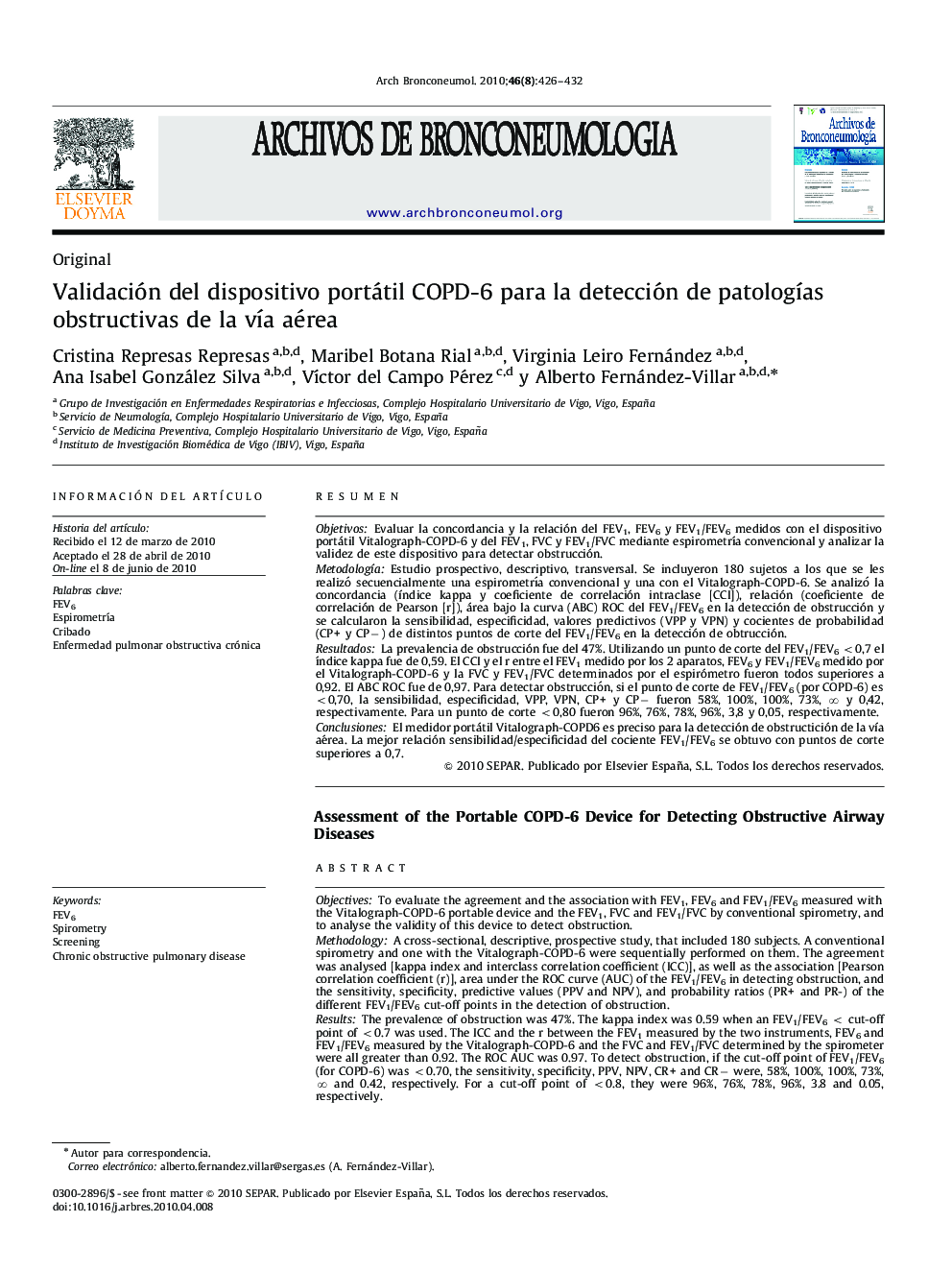| کد مقاله | کد نشریه | سال انتشار | مقاله انگلیسی | نسخه تمام متن |
|---|---|---|---|---|
| 4204186 | 1279573 | 2010 | 7 صفحه PDF | دانلود رایگان |

ResumenObjetivosEvaluar la concordancia y la relación del FEV1, FEV6 y FEV1/FEV6 medidos con el dispositivo portátil Vitalograph-COPD-6 y del FEV1, FVC y FEV1/FVC mediante espirometría convencional y analizar la validez de este dispositivo para detectar obstrucción.MetodologíaEstudio prospectivo, descriptivo, transversal. Se incluyeron 180 sujetos a los que se les realizó secuencialmente una espirometría convencional y una con el Vitalograph-COPD-6. Se analizó la concordancia (índice kappa y coeficiente de correlación intraclase [CCI]), relación (coeficiente de correlación de Pearson [r]), área bajo la curva (ABC) ROC del FEV1/FEV6 en la detección de obstrucción y se calcularon la sensibilidad, especificidad, valores predictivos (VPP y VPN) y cocientes de probabilidad (CP+ y CP−) de distintos puntos de corte del FEV1/FEV6 en la detección de obtrucción.ResultadosLa prevalencia de obstrucción fue del 47%. Utilizando un punto de corte del FEV1/FEV6 <0,7 el índice kappa fue de 0,59. El CCI y el r entre el FEV1 medido por los 2 aparatos, FEV6 y FEV1/FEV6 medido por el Vitalograph-COPD-6 y la FVC y FEV1/FVC determinados por el espirómetro fueron todos superiores a 0,92. El ABC ROC fue de 0,97. Para detectar obstrucción, si el punto de corte de FEV1/FEV6 (por COPD-6) es <0,70, la sensibilidad, especificidad, VPP, VPN, CP+ y CP− fueron 58%, 100%, 100%, 73%, ∞ y 0,42, respectivamente. Para un punto de corte <0,80 fueron 96%, 76%, 78%, 96%, 3,8 y 0,05, respectivamente.ConclusionesEl medidor portátil Vitalograph-COPD6 es preciso para la detección de obstructición de la vía aérea. La mejor relación sensibilidad/especificidad del cociente FEV1/FEV6 se obtuvo con puntos de corte superiores a 0,7.
ObjectivesTo evaluate the agreement and the association with FEV1, FEV6 and FEV1/FEV6 measured with the Vitalograph-COPD-6 portable device and the FEV1, FVC and FEV1/FVC by conventional spirometry, and to analyse the validity of this device to detect obstruction.MethodologyA cross-sectional, descriptive, prospective study, that included 180 subjects. A conventional spirometry and one with the Vitalograph-COPD-6 were sequentially performed on them. The agreement was analysed [kappa index and interclass correlation coefficient (ICC)], as well as the association [Pearson correlation coefficient (r)], area under the ROC curve (AUC) of the FEV1/FEV6 in detecting obstruction, and the sensitivity, specificity, predictive values (PPV and NPV), and probability ratios (PR+ and PR-) of the different FEV1/FEV6 cut-off points in the detection of obstruction.ResultsThe prevalence of obstruction was 47%. The kappa index was 0.59 when an FEV1/FEV6 < cut-off point of <0.7 was used. The ICC and the r between the FEV1 measured by the two instruments, FEV6 and FEV1/FEV6 measured by the Vitalograph-COPD-6 and the FVC and FEV1/FVC determined by the spirometer were all greater than 0.92. The ROC AUC was 0.97. To detect obstruction, if the cut-off point of FEV1/FEV6 (for COPD-6) was <0.70, the sensitivity, specificity, PPV, NPV, CR+ and CR− were, 58%, 100%, 100%, 73%, ∞ and 0.42, respectively. For a cut-off point of <0.8, they were 96%, 76%, 78%, 96%, 3.8 and 0.05, respectively.ConclusionsThe portable Vitalograph-COPD6 device is precise for the detection of airway obstruction. The best sensitivity/specificity of FEV1/FEV6 was obtained with cut-off points greater than 0.7.
Journal: Archivos de Bronconeumología - Volume 46, Issue 8, August 2010, Pages 426–432